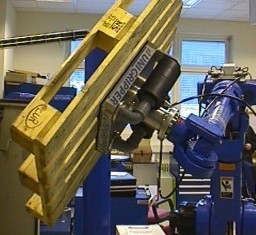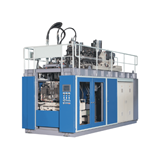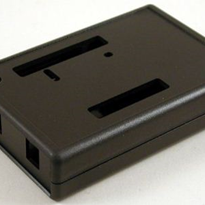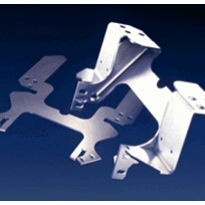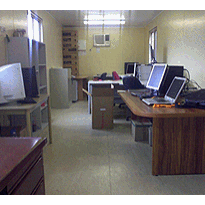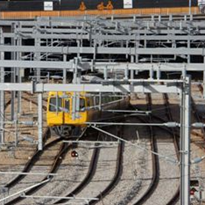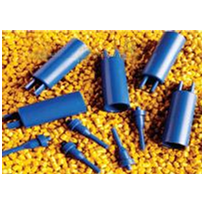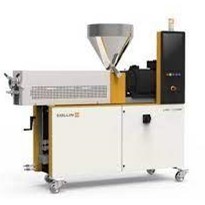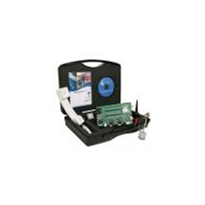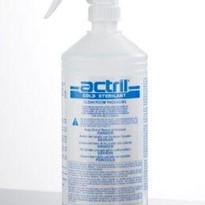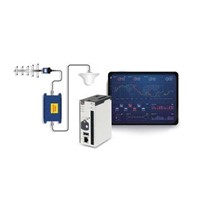Not so long ago, the implementation of a robot cell or automated process meant not only selecting the appropriate robot or loader system, but also the design of a suitable gripper system that would reliably cope with the non-stop 24/7 duty cycle expected from such unmanned processes.
In Australian manufacturing industry alone there are already thousands of robots in active service with the forecast that these numbers will grow significantly over the next 5 to 10 years. The driver of this growth is the amount of technology now packed into an economical off-the-shelf robot.
This increase in robot populations has led to the availability of a vast range of standard gripper systems which are designed to enhance the performance of the robots they are fitted to. These gripper systems need to be rugged, precision devices which can stand up to the various application, environmental and duty cycle requirements of a given manufacturing process.
Designers of robot installations want to avoid special grippers which invariably take longer to design and debug, often leading to cost and lead time blow-outs. Selection of standard, proven gripper systems allows the designer to confidently download CAD data directly into their designs. Only the shape and form of the gripper contact fingers need to be specially designed.
The worlds leading manufacturer of finger type grippers, Schunk GmbH, offers a huge selection of 2, 3 and 4 finger grippers in parallel, angular and concentric versions. Whether the application is to grip onto a small needle, a light globe, a cut of meat, or to carry a heavy cast engine block, a standard gripper with suitable performance characteristics can be selected.
These standard finger type grippers are provided with either pneumatic, hydraulic or electrical actuation, once again depending on the application requirements. In each case full selection data is provided including admissible forces and moments which can be applied to the fingers.
All finger type grippers are available with position detection switches and some even have the option of flexible positioning sensors where stroke monitoring of up to 5 positions is possible. In addition, Schunk also offers a full line of compatible swivel and linear units which can be combined with the gripper/s to provide additional degrees of freedom.
In packaging and material handling applications it is often desirable for one gripper to accommodate several different products. For instance, the UniGripper from Tepro of Sweden is an intelligent vacuum gripper system that automatically senses the position of products and creates the necessary lifting force where it is needed.
This unique patented feature allows UniGripper to handle pallets, crates, boxes, barrels, steel plates and corrugated sheets. Items such as bottles, cans, bricks and glasses can be handled in singles, trays or full layers with, or without shrink wrapping.
UniGripper is also available in several variants including SideGripper for barrels and heavy boxes; LayerGripper for pallets/layers; and BottleGripper for full and empty bottles.
Some applications require a more flexible design approach which has led to the development of modular gripper systems which can be constructed from standard module components.
Tunkers Maschinenbau offers a modular gripper system for automotive body shop applications where the gripper is designed according to the geometry of the panel being handled. The gripper frame consists of aluminum tubes which are joined together by standard connectors and joints to provide a flexible, light weight but rigid construction. To this frame is mounted the various gripper elements such as vacuum cups, location pins, pneumatic grippers and detection switches to accurately position and secure the workpiece.
These grippers are designed to ‘give’ in the case of a crash situation, thus protecting the gripper and robot from serious damage. A series of reference holes allow the gripper to be quickly returned to its original geometry.
Modular grippers from SAS Grippers are designed for handling moulded plastic parts where an extremely light weight gripper is needed. Typically these grippers are mounted onto robots or dedicated unloaders which service injection moulding machines.
The SAS Gripper system comprises extruded alloy profiles which are secured by a standard range of connectors and clamps to provide the basic gripper frame. To this frame a selection of mountings are available to secure grippers, vacuum cups and sprue pliers etc.
Further elements such as air nippers and static eliminators can also be incorporated to perform additional functions during the handling process, making the gripper a working tool.
Users can order specific components to build a gripper, or alternatively select from a range of standard SAS Gripper kits which comprise everything needed to build a gripper.
A huge benefit of the modular gripper systems using standard parts is that the components can be re-used when new or re-designed workpieces are introduced. This means that gripper costs are significantly reduced over the lifetime of the systems.
In more complex automation applications it may be necessary for the robot to use more that one gripper or tool to complete the process. This can be solved through the use of robotic tool changers with an automatic quick release feature.
ATI-Industrial Automation tool changers are used extensively to provide fast changeover from one gripper (or tool) to another while providing air, vacuum, water and electrical feeds for the gripper operating elements. ATI’s range of robot end effectors also includes crash protectors, compensator units to assist in automated assembly tasks and force/torque sensors which provide a degree of ‘feel’ and control over the amount of force exerted at the gripper/tool.
Romheld Australia specializes in quality gripper systems and robotic EOAT (end-of-arm-tooling) technologies for robot integrators and manufacturing industry.
- Suppliers
- New to IndustrySearch? Book a Demo
- Advertise with us
- Login
- Email Marketing
- Buyers
- Get Quotes
- Articles & Ideas
- Login
- Subscribe to newsletter
- My Details
- Get Quotes
- Automation & Control
- Automotive Workshop Equipment
- Commercial Cleaning Equipment & Supplies
- Construction Equipment & Heavy Machinery
- Conveyor Systems & Components
- Electrical & Power Generation Equipment
- Electronic Components
- Farming & Agriculture
- Food & Beverage Processing
- Forklifts & Forklift Attachments
- Hydraulic & Pneumatic Equipment
- Industrial Materials, Tools & Components
- Industrial Pumps
- IT Hardware & Industrial Computing
- IT Software & Applications
- Laboratory Equipment & Instruments
- Manufacturing & Industrial Equipment
- Material Handling & Lifting Equipment
- Metalworking & Machining
- Mining Equipment & Machinery
- Packaging & Labelling Machinery
- Pallet Handling Equipment
- Personal Protective Equipment
- Security & Surveillance
- Test & Measurement
- Transport & Logistic Equipment
- Warehouse Storage, Shelving & Racking
- Waste Treatment & Environmental Management
- Welding Machines & Accessories
- Woodworking & Joinery Machines
- Workplace Equipment
- Workplace Safety Equipment
- Get Quotes
- Automation & Control
- Automotive Workshop Equipment
- Commercial Cleaning Equipment & Supplies
- Construction Equipment & Heavy Machinery
- Conveyor Systems & Components
- Electrical & Power Generation Equipment
- Electronic Components
- Farming & Agriculture
- Food & Beverage Processing
- Forklifts & Forklift Attachments
- Hydraulic & Pneumatic Equipment
- Industrial Materials, Tools & Components
- Industrial Pumps
- IT Hardware & Industrial Computing
- IT Software & Applications
- Laboratory Equipment & Instruments
- Manufacturing & Industrial Equipment
- Material Handling & Lifting Equipment
- Metalworking & Machining
- Mining Equipment & Machinery
- Packaging & Labelling Machinery
- Pallet Handling Equipment
- Personal Protective Equipment
- Security & Surveillance
- Test & Measurement
- Transport & Logistic Equipment
- Warehouse Storage, Shelving & Racking
- Waste Treatment & Environmental Management
- Welding Machines & Accessories
- Woodworking & Joinery Machines
- Workplace Equipment
- Workplace Safety Equipment
Trusted by 1,000,000+ Australian industrial buyers
Buyers
- Discover products & solutions
- Login
- Subscribe To Newsletter
- Browse All Products
- Read Articles
Suppliers
Advertise
- Promote your products & solutions
- New to IndustrySearch? Book a Demo
- Login / Forgot Password
- Advertise Your Products
- Success Stories
- Email Marketing
- Suppliers
- Advertise with us
- Login
- Email Marketing
- Buyers
- Get Quotes
- Articles & Ideas
- Login
- Subscribe to newsletter
- My Details
Get Quotes
- Automation & Control
- Automotive Workshop Equipment
- Commercial Cleaning Equipment & Supplies
- Construction Equipment & Heavy Machinery
- Conveyor Systems & Components
- Electrical & Power Generation Equipment
- Electronic Components
- Farming & Agriculture
- Food & Beverage Processing
- Forklifts & Forklift Attachments
- Hydraulic & Pneumatic Equipment
- Industrial Materials, Tools & Components
- Industrial Pumps
- IT Hardware & Industrial Computing
- IT Software & Applications
- Laboratory Equipment & Instruments
- Manufacturing & Industrial Equipment
- Material Handling & Lifting Equipment
- Metalworking & Machining
- Mining Equipment & Machinery
- Packaging & Labelling Machinery
- Pallet Handling Equipment
- Personal Protective Equipment
- Security & Surveillance
- Test & Measurement
- Transport & Logistic Equipment
- Warehouse Storage, Shelving & Racking
- Waste Treatment & Environmental Management
- Welding Machines & Accessories
- Woodworking & Joinery Machines
- Workplace Equipment
- Workplace Safety Equipment
Get Quotes
- Automation & Control
- Automotive Workshop Equipment
- Commercial Cleaning Equipment & Supplies
- Construction Equipment & Heavy Machinery
- Conveyor Systems & Components
- Electrical & Power Generation Equipment
- Electronic Components
- Farming & Agriculture
- Food & Beverage Processing
- Forklifts & Forklift Attachments
- Hydraulic & Pneumatic Equipment
- Industrial Materials, Tools & Components
- Industrial Pumps
- IT Hardware & Industrial Computing
- IT Software & Applications
- Laboratory Equipment & Instruments
- Manufacturing & Industrial Equipment
- Material Handling & Lifting Equipment
- Metalworking & Machining
- Mining Equipment & Machinery
- Packaging & Labelling Machinery
- Pallet Handling Equipment
- Personal Protective Equipment
- Security & Surveillance
- Test & Measurement
- Transport & Logistic Equipment
- Warehouse Storage, Shelving & Racking
- Waste Treatment & Environmental Management
- Welding Machines & Accessories
- Woodworking & Joinery Machines
- Workplace Equipment
- Workplace Safety Equipment
Trusted by 1,000,000+ Australian industrial buyers


